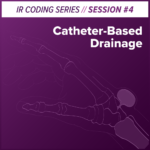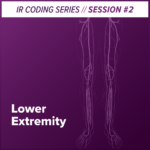As with most things, for vascular IR coding it’s important to diligently maintain foundational knowledge while continuing to build – because, if there’s one thing we can be sure of with IR coding it’s that, at some point, it’s going to change. A stable foundation allows us to absorb those changes with a little more ease and confidence.
The start of a new year is the best time to re-set and refresh foundational knowledge with a review of vascular IR coding fundamentals. Over the years, the trend with codes has been a move back to “bundled codes” – meaning a single code to describe the entire procedure. While most interventional, and many diagnostic, services are now defined by bundled codes, there are still services that are reported with component coding.
Component Coding Rules
You must know where you started and where you ended up to correctly code for selective catheter placements.
Documentation must be clear on these points to ensure correct code assignment. For example, a statement such as “via the right groin approach” clearly defines the vascular access point.
When allowed, code each vascular family separately.
A vascular family is defined as a vessel that branches off the aorta or vena cava along with all secondary (and additional) vessels that branch from that vessel. So, this means that if the catheter is placed in the right and left subclavian arteries for imaging of the upper extremities, each would be separately coded. Assuming normal vascular anatomy, see code 36215 for the left subclavian and 36216 for the right subclavian.
When allowed, code to the highest degree of selectivity within a vascular family.
Review the RVUs for each of the codes. The lesser orders of selectivity are valued lower than the higher orders of selectivity. Simply stated, you cannot code for what you “pass through” to get to the more distal portion of the vessel.
When allowed, selective codes take precedence over non-selective codes if done from the same puncture site.
Again, a review of RVUs will show that non-selective codes (arterial: 36100, 36140, 36160 and 36200) carry lower values than selective options either above (36215–36218) or below the diaphragm (36245–36248). Similarly, venous non-selective options (36000, 36005 and 36010) carry lower RVUs than selective venous choices (36011 and 36012). Bundled or collapsed CPT options for dialysis fistula/graft imaging (36901–36909), arch, carotid and vertebral angiography (36221–36228) and unilateral and bilateral selective renal angiography (36251– 36254) are exceptions as these codes include valuation for both the S&I and surgical component of procedures.
When allowed, code each catheter placement from each separate puncture site individually (i.e., multiple punctures for placement of aortic endograft).
When more than one access site is used to gain entry into the vascular system, regardless of whether the catheter/device ends up in the same location, when allowed, each may be separately coded. To illustrate, if lower extremity venography is performed via separate needle placements in the right and left foot, each placement and injection should be separately coded. A single S&I code would be used to define imaging.
Code to the intent of the study.
If attempting to place a catheter into the abdominal aorta and the catheter inadvertently goes into the renal artery, while the renal artery is by definition a “selective” placement, it should not be coded as such as this was not the initial intent.
When allowed, if both diagnostic and therapeutic studies are performed in the same session, be certain to code separately for each portion.
The key here is to clearly understand the definition of any and all CPT codes being assigned or those being contemplated for assignment. The trend is that new codes that have been bundled/collapsed will include all parts of the study. Some allow separate coding of imaging with the intervention when performed in a full and complete fashion (see 37220–37235 or 37211–37214) and others include both imaging and intervention (i.e., TIPS procedures, cervical carotid stent placement, intracranial angioplasty with or without stent, etc.). You must review current CPT language to determine what is allowed or considered to be bundled/packaged into the intervention.
Do not code for the forming of catheters.
While not routinely done, this may occur when performing visceral or pelvic angiography. The catheter/device is “shaped” inside the patient in a vessel and then advanced into another vessel. The term “Waltman’s loop” indicates this shaping or forming.
Only one second or third order vessel within a vascular family can be described by a second or third order code. See codes 36218 or 36248 for arterial studies, 36012 for venous studies, or 36015 for pulmonary angiography.
As stated previously, you will always code to the highest degree of selectivity reached in each family. You also may not code for a vessel that you must pass through to reach this higher degree of selectivity. Arterially, code 36218 or 36248 is not used when more than one second- or third-order vessel is studied in separate vascular families. In this instance, each separate family is coded individually to the highest degree of selectivity reached in each.
Simple, right? Absolutely not, and that’s why it’s important to diligently maintain foundational knowledge while continuing to build – because, if there’s one thing we can be sure of with IR coding it’s that, at some point, it’s going to change. A stable foundation allows us to absorb those changes with a little more ease and confidence.
Master the Fundamentals of IR Coding
Join us for the first installment of our 11-part interventional radiology coding series, now available on-demand, featuring prominent interventional radiology coding expert Jeff Majchrzak, BA, RCC, CIRCC.
This session provides a foundation for interventional radiology coding with an opportunity to reset and get grounded in a broad range of coding basics – covering terminology, vascular anatomy, modifiers, CCI fundamentals, and bundled and component coding rules for diagnostic and therapeutic IR services.













